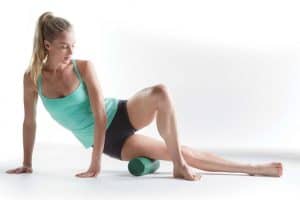Foam Rollers and IT Band Pain / Syndrome
Nowadays you can find foam rollers everywhere: the gym, your physical therapist’s office, your living room and even your suitcase. It seems that foam rolling has become one of the most favorite tools to alleviate many different aches and pains. It has also been claimed that rollers assist in restoring range of motion to our joints, as well as releasing tension and speeding recovery from injury. Releasing tension in the iliotibial band (ITB) is one of the most common uses for a foam roller.
To understand why the ITB is vulnerable to injury, we must understand the anatomy of the associated hip structures. On the side of our hips, the gluteus medius and the Tensor Fascia Latae (TFL) are two muscles primarily responsible for hip abduction, the motion of moving the leg away from the midline of the body. These muscles help to stabilize the pelvis, femur and knee joint during movement, particularly during the walking and running motions when our knees tend to shift medially or laterally.
The muscles that attach to the ITB are the Gluteus Maximus, the Tensor Fascia Latae (TFL) and the Vastus Lateralis (VL), all of which have a mechanical influence on the ITB.
Typically, the ITB is vulnerable with:
- Increased friction from repetitive action of the knee or hip, (such as running),
- Imbalance or mis-timing between the TFL and the gluteus medius
- Biomechanical factors that contribute to tightness of the Vastus Lateralis or Gluteus Maximus
- Genetic factors such as proportionately longer femurs, or wider pelvis
- A combination of the above
When are Foam Rollers helpful?
Clinically, one scenario that can be remedied with a foam roller is when the gluteus medius becomes deficient in its pelvic stabilization role. When this occurs, the TFL and the gluteus maximus become over-dominant and form trigger points and tightness that need release. The cause of this is variable but ultimately leads to undue stress and tightness on the IT band, inflammation, pain and dysfunction around the hip and knee.
The purpose of rolling muscle and fascial tissue with a foam roller is to create a lengthening effect on the taut structures that are contributing to the ITB symptoms. In this example, rolling the following muscles may be effective in alleviating pain, releasing tension and restoring mobility:
- Tensor Fascia Latae (TFL)
- Gluteus Maximus
- Vastus Lateralis
- Lateral Hamstrings
